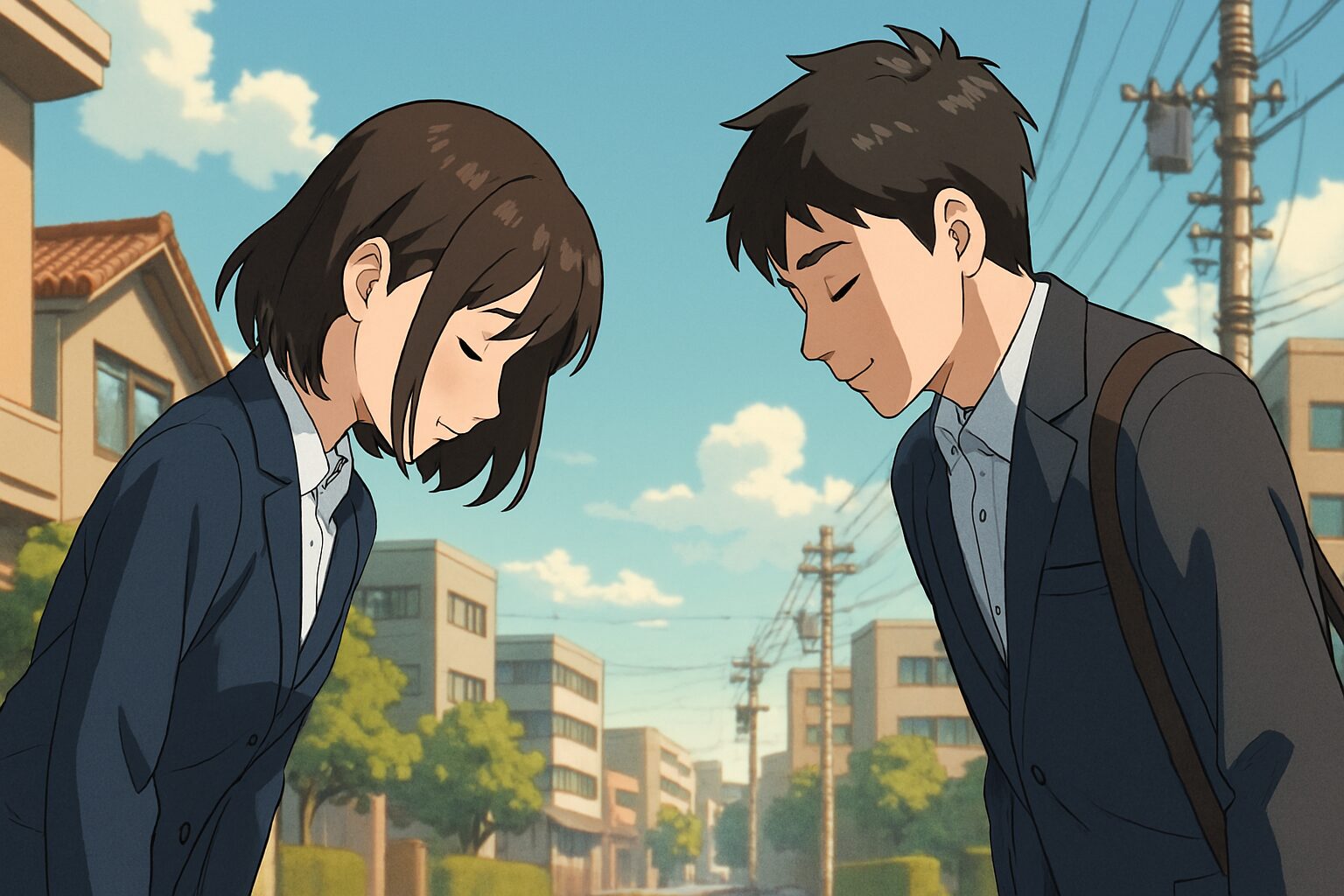- — The Philosophy of Respect Through Silence and Posture —
- Introduction: Bowing as a Language Beyond Words
- Types of Bows: Meaning in Angles and Duration
- Historical Roots: Bushido and the Ritual of the Body
- Bowing in Modern Japan: Unspoken Courtesy
- Global Comparison: Touch vs. Distance
- The Philosophy of Bowing: Dialogue in Silence
- A Message to Visitors: Try Bowing, Feel Japan
- Conclusion: Bowing Is Poetry in Silence
- ―身体に宿る敬意と沈黙の美学―
— The Philosophy of Respect Through Silence and Posture —
Introduction: Bowing as a Language Beyond Words
One of the first things foreign visitors notice in Japan is how often—and how deeply—people bow. Station staff, shop clerks, teachers, businesspeople, even children—bowing is woven into daily life.
But bowing in Japan is not just a greeting. It’s a nonverbal expression of emotion, respect, and social harmony, conveyed through the body rather than words.
This silent form of communication is deeply rooted in Japanese aesthetics. For a deeper look into this concept, explore: 👉 The Aesthetics of Silence: How Rei and Ma Shape Japan’s Wordless Communication
Types of Bows: Meaning in Angles and Duration
Japanese bowing is not random—it follows a precise etiquette depending on the situation. Here are the three main types:
| Type | Angle | Usage |
|---|---|---|
| Eshaku (light bow) | ~15° | Casual greetings, passing by |
| Keirei (formal bow) | ~30° | Business settings, customer service |
| Saikeirei (deep bow) | ~45° | Apologies, gratitude, ceremonial occasions |
The angle and duration of a bow reflect the depth of emotion and the social distance between people. Even if the words are the same, a 30° bow and a 45° bow communicate very different levels of sincerity.
Historical Roots: Bushido and the Ritual of the Body
While bowing has ancient origins, its refinement is closely tied to Bushido, the code of the samurai.
Samurai were expected to be both dangerous and dignified. Bowing became a way to signal, “I mean no harm. I respect you.”
In traditional arts like tea ceremony and Noh theater, graceful movements are essential. Bowing is not just etiquette—it’s a way to center the heart through the body.
For more on Japan’s philosophy of life and death, see: 👉 🇯🇵 The Japanese Philosophy of Life: From Samurai Death Ethics to Tokugawa’s Compassion Laws
Bowing in Modern Japan: Unspoken Courtesy
Today, Japanese people bow almost unconsciously. It’s deeply connected to the cultural value of “reading the air”—understanding others without words.
- A slight bow when giving up a seat on the train
- A backward glance and bow when leaving a shop
- A synchronized bow at the end of a meeting
These gestures express gratitude, humility, and social awareness—without saying a word.
Global Comparison: Touch vs. Distance
In many Western cultures, greetings involve physical contact—handshakes, hugs, pats on the back. In Japan, respect is often shown by maintaining distance.
Bowing is a way to communicate deeply, silently, and respectfully. It reflects the Japanese belief that actions speak louder than words.
The Philosophy of Bowing: Dialogue in Silence
Bowing is more than politeness. It’s a philosophical act of self-restraint and reverence.
- Lowering oneself to elevate the other
- Avoiding eye contact to express humility
- Bowing together to create harmony and mutual respect
In this way, bowing embodies Japanese aesthetics of empathy, silence, and subtlety.
A Message to Visitors: Try Bowing, Feel Japan
If you visit Japan, try bowing. It’s a gesture that transcends language—a silent greeting from the heart.
And when someone bows to you, know that it may mean: “I respect you.” “Thank you.” “I’m sorry.” All wrapped in one quiet, graceful motion.
Conclusion: Bowing Is Poetry in Silence
Japanese bowing is poetry without words. It’s a way to communicate emotion, respect, and connection through posture and presence.
“Why Japan?” Perhaps the answer lies in this simple act: Lowering the head to elevate the heart.
なぜ日本人はお辞儀をするのか?
―身体に宿る敬意と沈黙の美学―
はじめに:言葉より深い「お辞儀」という言語
日本を訪れた外国人が最初に驚くことのひとつが、「お辞儀」の多さとその繊細さです。駅員、店員、学校の先生、ビジネスマン、子どもまで――日本では日常のあらゆる場面で人々が頭を下げます。
それは単なる挨拶ではありません。 お辞儀は、日本人が言葉にしない感情や敬意を、身体を通して伝える方法なのです。
この“沈黙のコミュニケーション”については、こちらの記事でも詳しく掘り下げています: 👉 The Aesthetics of Silence: How Rei and Ma Shape Japan’s Wordless Communication
お辞儀の種類:角度と時間に宿る意味
日本のお辞儀には、状況に応じた「型」があります。代表的なものは以下の3つです。
| 種類 | 角度 | 用途 |
|---|---|---|
| 会釈(えしゃく) | 約15度 | 軽い挨拶、すれ違い時など |
| 敬礼(けいれい) | 約30度 | ビジネスシーン、来客対応など |
| 最敬礼(さいけいれい) | 約45度 | 深い謝罪、感謝、儀式的場面 |
この角度の違いは、相手との距離感や感情の深さを表しています。 言葉では「ありがとう」と同じでも、30度と45度では伝わるニュアンスがまったく異なるのです。
歴史的背景:武士道と身体の礼儀
お辞儀の文化は、古代から存在していましたが、特に武士道の影響が大きいとされています。
武士は、刀を持つ危険な存在でありながら、礼節を重んじることが求められました。 お辞儀は、「私は敵意がありません」「あなたを尊敬しています」という非言語のメッセージとして機能していたのです。
また、茶道や能などの伝統芸能でも、所作の美しさが重視されます。 お辞儀は、身体を通して心を整える行為でもあるのです。
武士道と死生観については、こちらの記事もおすすめです: 👉 🇯🇵 The Japanese Philosophy of Life: From Samurai Death Ethics to Tokugawa’s Compassion Laws
現代の日本におけるお辞儀:無意識の礼儀
現代の日本人は、意識せずとも自然にお辞儀をします。 それは、「空気を読む」文化と深く関係しています。
- 電車で席を譲ったとき、軽く頭を下げる
- 店を出るとき、振り返って一礼する
- 会議の終わりに、全員が同時に頭を下げる
これらはすべて、言葉にしない感謝や配慮の表れです。 日本では、「言わなくても伝わる」ことが美徳とされる場面が多く、お辞儀はその象徴なのです。
海外との比較:握手、ハグ、そして沈黙
欧米では、挨拶に握手やハグが使われます。 それらは接触による親密さの表現ですが、日本では逆に距離を保つことで敬意を示す傾向があります。
お辞儀は、相手に触れず、沈黙のまま、しかし深く心を伝える方法。 それは、「言葉よりも行動が雄弁である」という日本的価値観の表れです。
お辞儀の哲学:沈黙の中にある対話
お辞儀は、単なる礼儀ではありません。 それは、自分を一歩引いて、相手を立てる行為です。
- 自分の存在を小さくすることで、相手への敬意を示す
- 相手の目を見ず、沈黙することで、言葉以上の感情を伝える
- 同時に頭を下げることで、共感と調和を生む
このように、お辞儀には日本人の美意識と哲学が宿っています。
海外の人へのメッセージ:お辞儀を通して日本を感じる
もしあなたが日本を訪れるなら、ぜひ一度、お辞儀をしてみてください。 それは、言葉を超えた“心の挨拶”です。
そして、日本人があなたにお辞儀をしたときは、 それが「あなたを尊重しています」「ありがとう」「ごめんなさい」のどれかであることを、 静かに感じ取ってみてください。
まとめ:お辞儀は、沈黙の中の詩
日本のお辞儀は、沈黙の中にある詩です。 それは、言葉に頼らず、身体を通して心を伝える美しい文化。
「Why Japan」――その答えのひとつは、 “頭を下げることで、心を高める”という、日本人の感性にあるのかもしれません。



コメント